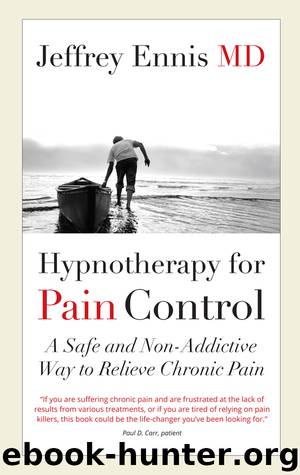Hypnotherapy for Pain Control by Jeffrey Ennis

Author:Jeffrey Ennis
Language: eng
Format: epub
Publisher: Barlow Publishing
7
The Science Behind Hypnosis: Does It Work? How?
Hypnosis has a long and storied history in medicine and on the stage. But the question you might ask is this: How does it work? Is there research evidence that it works to control pain? I know it’s worked for me, and I’ve seen it work for my patients. But that’s not a sufficient proof. How can we prove it works? To explore the question, let’s begin by asking what hypnosis is.
The best definition I’ve found comes from a textbook by David Spiegel and Jose Maldonado, professors at Stanford University: Hypnosis is a natural state of aroused, attentive focal concentration with relative suspension of peripheral awareness. It involves an intensity of focus that allows the hypnotized person to make maximal use of innate abilities to control perception, memory, and somatic function.
The way I think of it is a bit simpler. Hypnosis is a state of narrowed attention to one’s internal state. In this state a person can gain better control over their own natural abilities to control pain.
When most people think of hypnosis, they’re thinking of stage hypnosis—when a hypnotist finds a subject, does a very dramatic induction, and the person falls into a deep trance. They are then asked to do something unusual like think they are a chicken and the person starts clucking. Although entertaining this has nothing to do with clinical hypnosis.
One of the key features of stage hypnosis is suggestibility. Suggestibility means that a person accepts what is said without volition or choice. The normal emotional, social, and intellectual critical filters are shut off. It is like almost any other human characteristic. Some people have a lot, and some have a little, with most people being somewhere in the middle.
For the stage hypnotist, a critical part of the job is finding good subjects—people who are most likely to follow the hypnotist’s suggestions with the understanding that these suggestions will not be harmful and the entire process is meant to be enjoyable. That’s why the stage hypnotist typically comes out before the performance begins and goes through a series of exercises with the audience. He’s looking for the candidates who are suggestible and can help him create an entertaining performance.
Scientific researchers have even devised a way to test how suggestible a person is. It’s the Stanford Hypnotic Susceptibility Scale, developed in 1959. The tester reads out some small hypnotic inductions and the subject measures how deeply they felt what was being suggested. If the tester asks the subject to imagine putting his hand in very cold water, the subject then measures on a 10-point scale how cold his hand actually felt. It’s far from perfect, but it is the most commonly used test of suggestibility.1
Highly suggestible people are great subjects for stage hypnotism, and, based on my observations, they tend to learn how to do self-hypnosis more quickly and to get better results. I can see that in one of my patients, Peter, who is very suggestible. He learned how to do self-hypnosis very quickly and he gets very good pain control.
Download
This site does not store any files on its server. We only index and link to content provided by other sites. Please contact the content providers to delete copyright contents if any and email us, we'll remove relevant links or contents immediately.
| Administration & Medicine Economics | Allied Health Professions |
| Basic Sciences | Dentistry |
| History | Medical Informatics |
| Medicine | Nursing |
| Pharmacology | Psychology |
| Research | Veterinary Medicine |
The Poisoner's Handbook by Deborah Blum(1984)
Bottle of Lies by Katherine Eban(1707)
Mycelium Running: How Mushrooms Can Help Save the World by Paul Stamets(1584)
The Vaccine Race by Meredith Wadman(1564)
Missing Microbes by Martin Blaser(1522)
Pharmacy Practice and The Law by Richard Abood(1496)
The Doors of Perception and Heaven and Hell by Aldous Huxley & Aldous Huxley(1491)
Decisive by Chip Heath(1458)
Steroids: History, Science, and Issues by Standora Joan E.; Bogomolnik Alex; Slugocki Malgorzata(1428)
28 Seconds by Michael Bryant(1422)
The Doors of Perception: Heaven and Hell (thINKing Classics) by Aldous Huxley(1414)
McGraw-Hill Nurses Drug Handbook by Patricia Schull(1403)
Ganja Yoga by Dee Dussault(1388)
What's Making Our Children Sick? by Michelle Perro(1352)
Complete Guide to Prescription & Nonprescription Drugs 2014 by H. Winter Griffith(1283)
Stealing Fire: How Silicon Valley, the Navy SEALs, and Maverick Scientists Are Revolutionizing the Way We Live and Work by Steven Kotler & Jamie Wheal(1278)
Anatomy of an Epidemic by Robert Whitaker(1239)
Trip by Tao Lin(1235)
Cannabis for Chronic Pain by Rav Ivker(1167)
